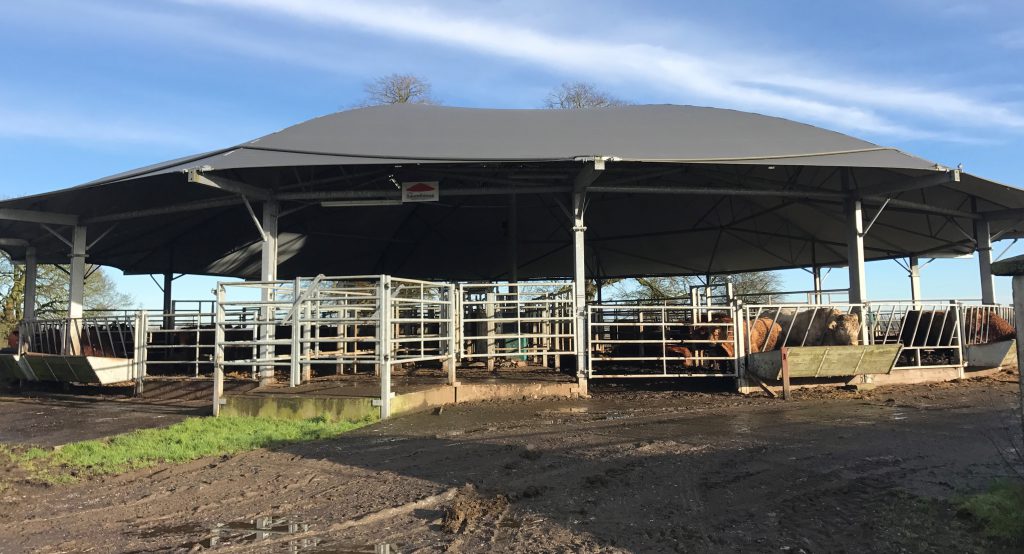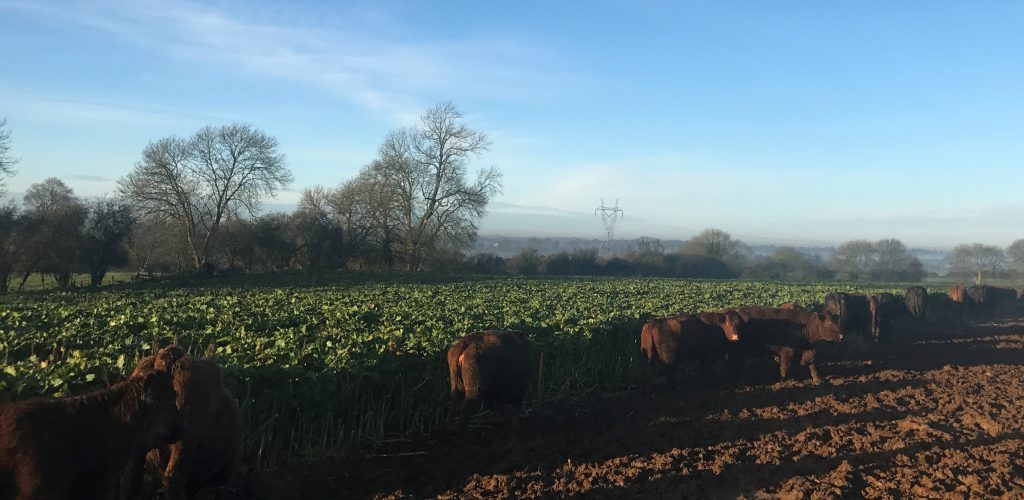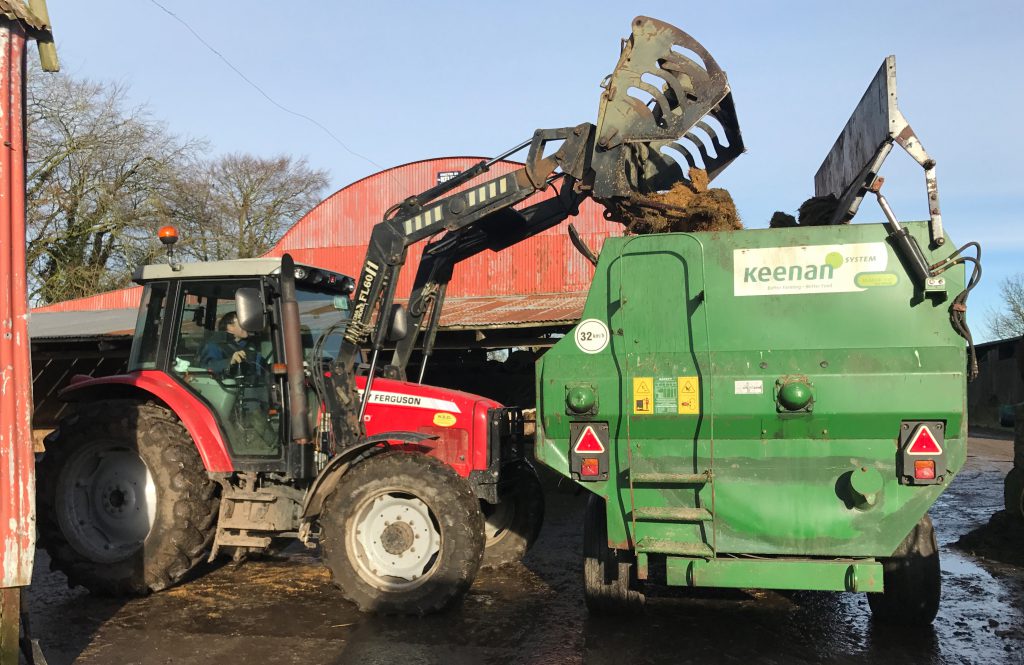The Cosgrave family has been beef farming in Newcastle, Co. Meath for three generations. James (Jnr), along with his father – James (Snr) – runs a herd of 150 cows and a flock of 250 ewes.
The thriving home farm stretches across 350ac. A further 80ac is rented approximately 16km away in Ballivor, Co. Meath.
Originally, his father ran a herd of 95 – predominately Black Angus cross and Limousin cross – cows sourced from the west of Ireland.
These cows were all put in-calf to Charolais bulls. James returned home from travelling in 1995 and it was at this time changes started to appear.
“Things were going alright. We were making some money, but not a lot. We had a man employed full-time at this stage so we needed to improve the output on the farm.”
In 1999, James (Jnr) set up his own herd – with a similar cow type to his father – running numbers up to 30. Most of the Charolais-sired offspring were sold as stores to repeat customers ever year.
James – who is the Leinster vice-president of the ICSA (Irish Cattle and Sheep Farmers’ Association) – said: “We also had some regular customers for breeding heifers and in-calf heifers. However, it became increasingly difficult to get a sustainable price from these beef finishers.
They weren’t making money and that was getting passed onto us.
“We were getting frustrated. We started looking around for a different type of cow and exploring different ideas on how to keep costs to a minimum,” he explained.
Luing cattle
It was at a national beef event in Scotland when James first set his eyes on Luing cattle – a breed that was developed in Scotland in 1966.
After discussing the matter with his father, James decided to “bite the bullet” and purchase some heifers. These heifers were sourced at a premiere sale in Castle Douglas, with the help of the McGowan family – Finlay, Judy, Neil and Clare.
Finlay was the field officer of the Luing Cattle Society at the time and Judy was the secretary. Together, they have been crucial to James’ Luing adventure.
He said: “I can’t say enough good about this family. They have been very good to us; offering advice and providing an excellent hospitality service.”
The first importation of 11 heifers arrived on the farm in March 2008 and, from that day to this, the Cosgrave family haven’t looked back. There has been a further seven importations of stock.
James – who is now a director in the Luing Cattle Society – explained exactly what attracted him to the breed, stating: “They are medium sized; easy kept; easy fleshed; and have the ability to produce good ‘growthy’ calves, whether they be sired by Charolais, Simmental, Limousin or bred pure.
“I now have a herd of 70 pure Luing cows and ‘Sim-Luing’ cows (Simmental X Luing). The Luing cows are bred to Simmental bulls and the Sim-Luing cows are bred to Charolais bulls. Some replacements are kept, while surplus heifers are sold in-calf every year.
Any of the heifers that we don’t keep for breeding are sold for beef.
A good set-up is key
James uses stock bulls but also carries out some AI on the farm. The herd is split into two groups.
“We are about 90% spring and 10% autumn-calving. We have about 20 autumn-calvers. We feel that we are around the cattle enough to be able to spot cows coming into heat,” he explained.
It’s also very easy to pick up activity at night with the camera in the shed.
“We have a very good local AI man – as was his predecessor – who will come to us at the first chance he gets. We have very good success with AI.”
All the straws are sourced from Progressive Genetics. James has used semen from Simmental bulls such as Frosty King; Anatrim Body Builder; Seepa Tee Jay; and Keeldrum Capone. Charolais bulls used include Fiston and Crossmolina Euro.
“We have cameras set up in all the calving sheds. We are a bit different than most farmers; we tend to calve in three different areas to cut down on disease.
“The calving season in spring 2017 was never as easy. However, we might have a cesarean every three-to-four years.
We will be hoping to have another calving season like 2017.
Out-wintering cattle
“We currently have 90 cows on 15ac of forage kale. They were let into it on the first week of November.”
James continued: “They have all been given an iodine bolus in mid-December and they will be there until the first or second week in February, all going well.
“With the kale, our wintering costs are significantly lower. We have been growing kale for about 12 years as a forage crop and we have had great success with it. We have also grazed fodder beet in the past.
At the end of the day, if your costs are too high you can’t recover those costs in the beef price.
Following the kale crop, a spring barley crop will be sown in mid-April and it will be harvested in August for whole-crop silage. This will be fed to the yearlings over the winter period.
Animal performance
Weanlings are fed a diet of whole-crop silage, grass silage and a 22% barley balancer ration at a rate of 2kg/head. The ration is also fortified with minerals and vitamins.
They will be fed this until February and the balancer will be removed two-to-three weeks prior to turn-out on grass.
“Stores will be sold at about 16 months-of-age, if the price is good enough. However, if I can’t get enough for the stores, we will bring them to beef ourselves,” he explained.
The finishing stock get hay, rolled barley (which is produced on the farm) and a balancer ration. The Charolais bulls are fed at a rate of 13-14kg/head. The Luing bulls receive 11kg/head.
In addition, one Limousin X Luing bull – slaughtered on November 20, 2017 – aged 20 months, had a carcase weight of 372kg and graded U= 3+. This animal killed out at 57.9%.
On the day that AgriLand visited the farm, James weighed his October-2016 born replacement heifers. These averaged 498kg. Therefore, these heifers are all on target for breeding in April – aged 17 months.
The future as beef farmers
James touched on the beef industry in Ireland and explained that the factories need to deliver back to the farmers and that it is not sustainable to produce quality beef animals at less than €4/kg.
“This is a family farm and we have no other source of income. If we don’t produce the goods, we don’t get paid. However, we are producing quality beef, but we are not getting paid enough for it.
“I’m not talking about €90,000 or €100,000 of a family farm income, but we need €50,000 to be sustainable. That’s what we want and that’s what we strive to do.”
James added: “It’s not only the price of the cattle we have to look at. It’s also the input costs that go into producing the beef – the veterinary costs, fertiliser costs and feed costs.
We are constantly being told to produce more and more, but we have to take less.
“The minute we get a rise in the beef price, the costs of products go up. There’s no point in us getting €4.50/kg if the price of everything else goes to the sky,” he explained.
“Two years ago corn gluten was approximately €127/t. Today, it is priced at approximately €180/t. All feed prices have risen in 2017 – especially proteins.
“There is no point in us being more efficient and the input costs rising. Look at fertiliser costs this year – they have increased by €50/t on last year.
“In regard to the Beef Data and Genomics Programme (BDGP), all our cattle are falling into the right category. We have no problem meeting the star ratings.”
Both James and his father are advocates of Teagasc, the BDGP and are involved in local discussion groups.
In relation to his Luing beef, he said: “There is excellent marbling throughout the beef. We supply some restaurants in the local area and they are very interested in the beef going forward.
“My plan is to extend this business and open up my own farm shop and sell my own beef here. I can stand over the quality assurance and offer full traceability from farm to fork.
“It’s a niche market and if I can get an extra 20-25c/kg for the beef I’ll be happy,” he concluded.









